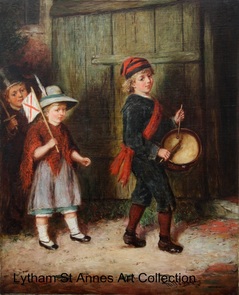The Drummer Boy
|
Research by Susan Auty
|
|
Acc N 15
Artist Mark William Langlois Artist dates 1848-1924 Medium oil on canvas Size 48.2 x 38.1 cm (19 x 15 in) Date painted unknown Donor Edward G Sergeant, Lytham In appreciation of the courtesy shown to him when he was the Chief ARP (Air Raid Precautions) Warden for Kirkham 1939-1931 Lord of the Manor of Kirkham until his death in1990 Date donated 18 March 1946 |
|
ARTIST
Very little is known about the artist or the provenance of the painting. Langlois is known to have been born in Surrey to a father who engaged in various artistic occupations, such as goldsmith, watchmaker and art dealer. Langlois appears to have achieved some popularity with still life, landscape and genre scenes in watercolour and oil between 1862 and 1873, when he is known to have exhibited at the Royal Academy. (1) There are newspaper reports in the 1870s and 1880s of his paintings being auctioned by private collectors but few merit a specific title, Langlois merely appearing in lists of largely unknown artists whose works were included in the auctions. (2) The titles mentioned suggest the popularity of his figurative work over landscape and still life: Pancake Day was auctioned in Leicester in 1882, Pet Rabbits was auctioned first in Cardiff in 1882 and then again in the same year in Portsouth, Village School was up for sale in Liverpool in 1888. (3) Today his genre paintings in oil are still the most popular of his works at sales. Since 1987 ninety-five of his paintings - of which only four are watercolours and two are still life - have been auctioned including, in 2013, a different version of a child drummer at play. PAINTING Little drummer boys accompanied the infantry in many armies in the 19th century and served a useful communications role. The little drummer boy became a familiar character at the time of the American Civil War in the 1860s. (4) A particularly famous depiction by Currier and Ives shows the boy with a feather in his cap (5), whereas Langlois depicts the girl wearing the feather. Here the boy is not formally attached to the military but is clearly pretending, making use of everyday items of clothing to suggest a uniform. The little girl, possibly a younger sibling, follows him with a St Patrick's saltire flag, suggesting possible Irish ancestry. (6) Children at play appears to be a favourite subject of Langlois. A pair of such paintings showing children playing at soldiers was auctioned in 2002. (7) Compulsory Service shows a little boy, in a stocking cap and holding a wooden toy sword, gripping the reins of a wooden horse on which his sister is mounted using a makeshift toy whip. Similarly, The Little Soldier shows a child dressing his dog in a stocking cap; the dog is perched on his hind legs with a toy rifle between his forepaws. The influence of Turner can be seen in the colouring and brushstrokes of the cave-like background which, it might be argued, is almost of more interest than the subject. All three paintings share a background showing signs of poverty with the children using their imaginations to engage in satisfying play. However, The Little Drummer Boy is the most accomplished of these works, as can be seen in the children's sweet expressions and the boy's skilfully drawn hands. The boy's eye contact with the viewer also seems designed to engage potential buyers and might account for the popularity of the image. |
REFERENCES
(1) Panvertu Art Gallery (www.panvertu.com/Langlois.htm) provides basic biographical details gleaned from census (2) Auction noticers were found in 19th century British Library Newspapers : Part II available online through Gale - via University and FE libraries Sources for paintings: Leicester Chronicle and the Leicestershire Mercury 21 January 1862, issue 3697, p1 Western Mail (Cardiff) 18,22,26 April, 3 May 1882 issues 4036, 4040, 4043, 4049, p1 |

